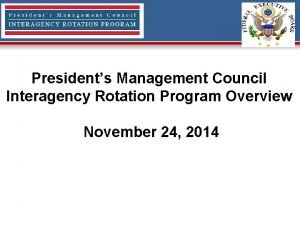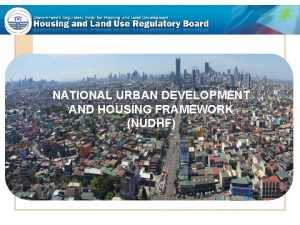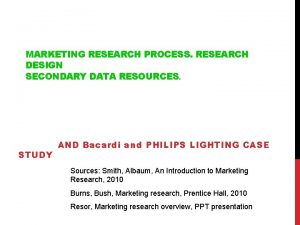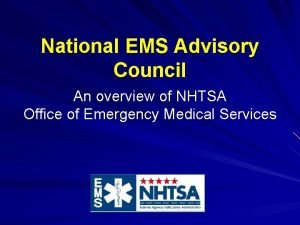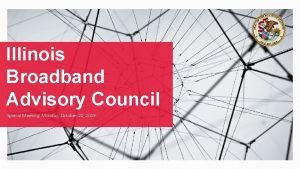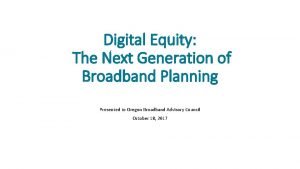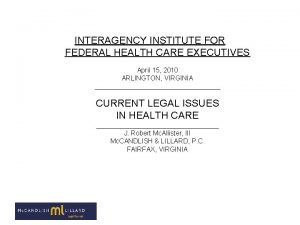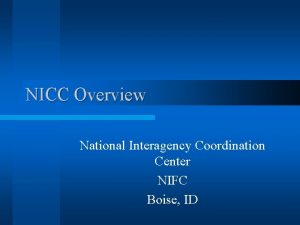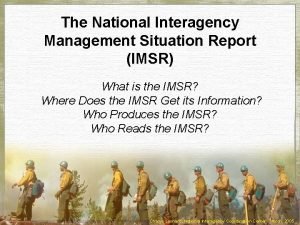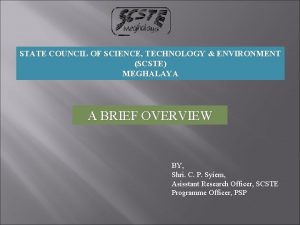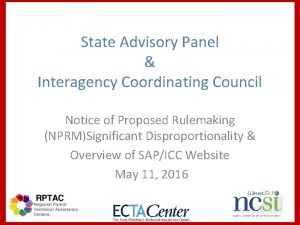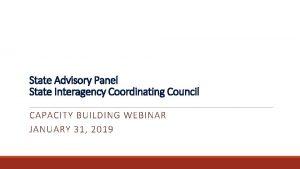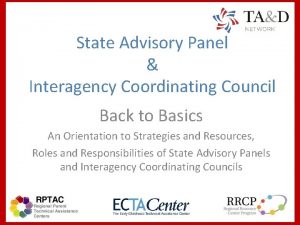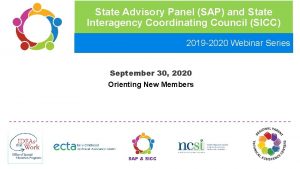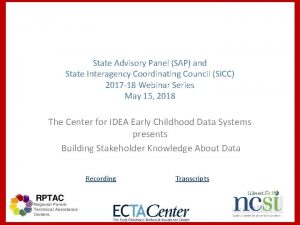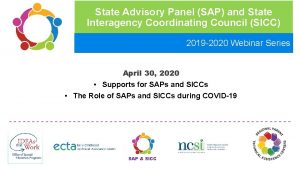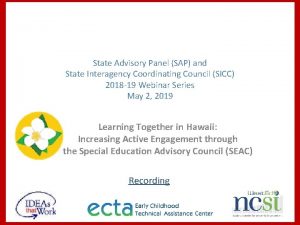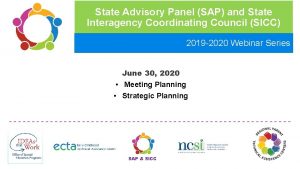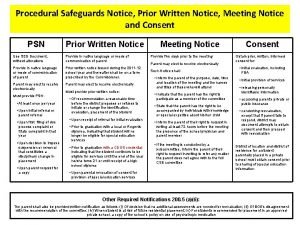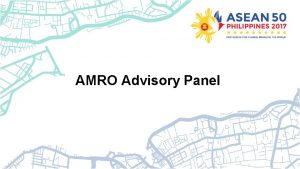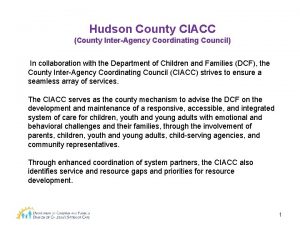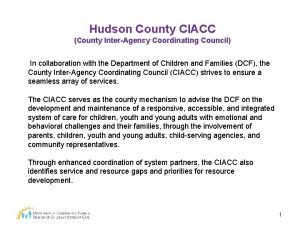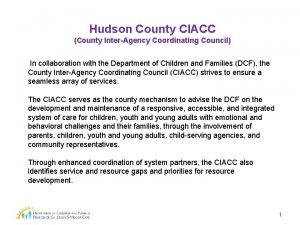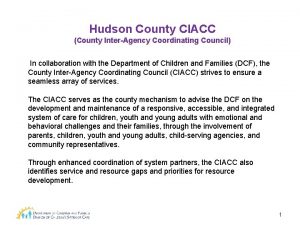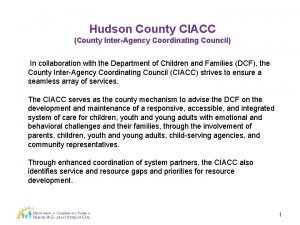State Advisory Panel Interagency Coordinating Council Notice of



















- Slides: 19

State Advisory Panel & Interagency Coordinating Council Notice of Proposed Rulemaking (NPRM)Significant Disproportionality & Overview of SAP/ICC Website May 11, 2016

Agenda • Welcome - Sharon Ringwalt • Logistics - Sharon Ringwalt • Conversation with Office of Special Education and Rehabilitative Services – Ruth Ryder, Deputy Director, Office of Special Education Programs (OSEP) • Presentations : – NPRM: Significant Disproportionality & Stakeholder engagement – Jill Harris – Overview of the revised National SAP/ICC website – Joanne Cashman • Questions (time permitting) – Perry Williams facilitates • Closing Comments and Announcements – Perry Williams

Your Experiences with Significant Disproportionality • What is to be gained by having meaningful stakeholder participation in decisions about determining significant disproportionality? • What situations can be avoided by more meaningful engagement? • Although disproportionality is primarily a school age issue, why should State Interagency Coordinating Councils ( SICCs) and early childhood providers be aware of issues around disproportionality in Part B services? • How might disproportionality be reflected in Part C data? or What does disproportionality look like for early intervention?

Background • The over-identification of children of color in special education is well documented. • Over-identification results in children being placed in more restrictive environments. • As a result, these children may not be taught to challenging academic standards.

Response from Congress • The current IDEA Part B regulations require States to identify LEAs where significant disproportionality may occur: – Significant disproportionality occurs where districts identify, place outside the regular classroom, or discipline children from any racial or ethnic group at markedly higher rates than their peers.

Current Regulation on Significant Disproportionality The State must: • Make an annual determination of significant disproportionality with respect to identification, placement, and discipline. • Require the LEA to reserve 15% of their IDEA, Part B funds to provide comprehensive, coordinated early intervening services (CEIS) to children who have not been identified as children with disabilities, in the LEA, particularly, but not exclusively, children in those groups that were significantly overidentified. • Provide for the review and revision, if necessary, of district policies, procedures, and practices to ensure compliance with the IDEA and report publicly on those revisions.

Additional Reporting • Report on 618 Table 8: • Whether the LEA was required to set aside CEIS funds and the reason(s) the LEA was identified for SD. • The number of children who received CEIS.

So What Data Resulted from Current Regulation? • In 2013, in a nation of over 15, 000 school districts, 356 districts were identified by states as demonstrating significant disproportionality. • This amounts to about 2 to 3 percent of all districts nationwide. • A GAO report in 2013 found that the discretion States have in defining SD has resulted in a wide range of definitions that provide no assurance that SD is being appropriately addressed.

Department’s Proposed Rule • The proposed rule in the NPRM will require that: – States use a standard approach to measure SD based on race and ethnicity in the LEA. • Use Risk Ratio Method • Set a reasonable risk ratio threshold, developed based on advice from stakeholders, (including the State Advisory Panels). • Set a minimum cell size no greater than 10.

Standard Approach Flexibilities Proposed Rule: State would have the flexibility to: • Use up to three years of data to identify an LEA. • Not identify LEAs if they are demonstrating reasonable progress, as determined by the State.

Review and Revision Proposed Rule: • States are required to, provide for the review, and if appropriate, revision of policies, procedures, and practices on an annual basis. • Identified LEAs must address the factors contributing to the significant disproportionality.

Comprehensive CEIS Proposed Rule: • Would allow LEAs identified with SD to use comprehensive CEIS to serve students, ages 3 through grade 12, with and without disabilities. • Would continue to prohibit LEAs from using comprehensive CEIS exclusively for students with disabilities.

Why is This Important to You? • Both the SICC and the SAP are statutorily required to review state-wide data related to the provision of services to children with disabilities. For example: • the SICC must submit an annual report on the status of EI services—usually the Part C APR. • the SAP must advise the SEA in developing evaluations and reporting on 618 data.

What Steps Can the SICC take? • Know your data: – Child find efforts are comprehensive and coordinated with required stakeholders. – All eligible infants and toddlers have access to timely and effective services. – Transition services effectively support toddlers and families. – Positive early childhood (social-emotional) and family outcomes. – Collaborative activities with key stakeholders (SEA, State Advisory Council on Early Childhood Ed. )

What Steps Can the SAP Take? • Identify the methodology that your State currently uses to identify SD. • Identify whether your State has identified SD in any LEA and for what reason. If so, what happened? • If the proposed rule is adopted, what could it mean for your State and key stakeholders?

What You Should Know… • The intent of the proposed regulation is not to limit services for children with disabilities who need them; rather, the purpose is to ensure that children are not mislabeled and receive appropriate services. • The SD NPRM is open for comment until May 16, 2016. • Submit your comments electronically at: www. regulations. gov

And… • Share the NPRM with others within the next four days. • Stay tuned for state and local discussions regarding SD. • Comment!

Questions? • Please use the chat area to type in your questions.

Introduction to the NEW SAP/SICC website! https: //www. stateadvisorypanel. org/ 19
 President's management council interagency rotation program
President's management council interagency rotation program National mathematics advisory panel
National mathematics advisory panel Coordinating european council
Coordinating european council National urban development and housing framework
National urban development and housing framework Continuous panel vs discontinuous panel
Continuous panel vs discontinuous panel Panel zıt panel
Panel zıt panel It-aac
It-aac Cadet advisory council
Cadet advisory council Source selection evaluation board
Source selection evaluation board President's advisory council on financial capability
President's advisory council on financial capability National ems advisory council
National ems advisory council Illinois broadband advisory council
Illinois broadband advisory council German advisory council on global change
German advisory council on global change Oregon broadband advisory council
Oregon broadband advisory council Interagency institute for federal health care executives
Interagency institute for federal health care executives National interagency coordination center
National interagency coordination center Interagency integrated triage tool
Interagency integrated triage tool Sit report fire
Sit report fire Interagency incident business management handbook
Interagency incident business management handbook Scste meghalaya
Scste meghalaya
